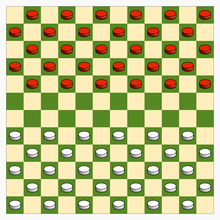Canadian lady
The Canadian checkers ( English : Canadian Checkers, Canadian Drafts) is a variant of the classic checkers game , which is especially common in Canada . Unlike the classic checkers game, it is usually played on a chessboard with 144 fields, 12 × 12.
The game was developed by French settlers in Quebec , who called it the Grand Jeu de Dames .
Style of play
As with the classic checkers game, the Canadian checkers is a board game for two players who sit across from each other on the game board. One player plays the white and the other the black pieces and the two players take turns making a move. In the starting grid, the 30 pieces are placed on the black fields of the first to third rows on both sides of the game board.
The colors are drawn or chosen, the white player begins the game. Both players now alternately each move a stone, whereby the stones can be moved diagonally forward on the black fields. When a player reaches the baseline on the opposite side, his stone becomes a queen (in English speaking “king” = “king”). This may move any number of fields in any diagonal direction, including backwards.
As with the classic checkers, a piece can be captured if a piece can jump over it onto a free field behind it. There is a compulsion to hit, so a stone must be hit if this is possible. The queen can capture any of the opponent's individual stones that are far away if there is a free space behind them. All captured stones are removed from the playing field after the move.
As in the classic checkers game, the winner is the player who succeeds in capturing all of the opponent's stones or immobilizing them. It is also possible to win the game if the opponent only has one stone left.
supporting documents
- ↑ a b c d e Canadian Checkers (Drafts) In: Brian Burns (Ed.): The Encyclopedia of Games. Brown Packaging Books, 1998; Pp. 158-159.
literature
- Canadian Checkers (Drafts) In: Brian Burns (Ed.): The Encyclopedia of Games. Brown Packaging Books, 1998; Pp. 158-159.
Web links
- Association Québécoise des joueurs de dames (AQJD) , official website of the Quebec Ladies' Association (French)
- Canadian Checkers in the game database BoardGameGeek (English)
